
instructions for tie dye washing
Tie-dye washing involves unique techniques to preserve vibrant colors and patterns. Proper methods ensure colors stay bold and prevent fading‚ making it essential for long-lasting results.
1.1 What is Tie-Dye?
Tie-dye is a traditional textile art form involving folding‚ twisting‚ or binding fabric to create resistance areas that prevent dye from penetrating evenly. This technique results in unique‚ vibrant patterns. Common materials like rubber bands or string are used to tie the fabric‚ and the process can be applied to various fabrics‚ including cotton‚ silk‚ and rayon. Each tie-dye piece is distinct‚ making it a popular method for creating artistic and personalized clothing. Special care is required to maintain the colors and patterns during washing.
1.2 Importance of Proper Washing Techniques
Proper washing techniques are crucial to preserve the vibrant colors and unique patterns of tie-dye fabrics. Improper methods can lead to fading‚ uneven color distribution‚ or damage to the material. Using the right detergents‚ water temperatures‚ and rinsing methods ensures the longevity of the design. Additionally‚ washing tie-dye items separately prevents dye transfer to other clothes. Following specific care instructions helps maintain the integrity and appearance of the fabric‚ keeping it looking fresh and colorful for a longer period. Proper care also extends the life of the garment.

Preparation Steps Before Washing
Preparation involves washing fabric before dyeing to remove impurities and using the right detergent. Properly dissolving dye and ensuring fabric is damp is essential.
2.1 Washing the Fabric Before Dyeing
Washing the fabric before dyeing is a crucial step. It removes impurities‚ softeners‚ and finishes that might interfere with dye absorption. Use a mild detergent without fabric softeners or bleach. Ensure the fabric is clean and damp but not soaking wet. This ensures even dye distribution. For best results‚ avoid using fabric softener or dryer sheets‚ as they can repel dye. Gently squeeze out excess water before proceeding to dye.
2.2 Choosing the Right Detergent
Selecting the right detergent is vital for tie-dye success. Opt for a mild‚ dye-safe detergent without bleach or fabric softeners‚ as these can interfere with color absorption. Avoid harsh chemicals that might damage fibers or fade colors. Eco-friendly or phosphate-free detergents are ideal for natural fabrics like cotton. For synthetic fibers‚ choose a detergent designed for color protection. Always follow the detergent’s instructions for proper measurement to avoid over-sudzing‚ which can hinder dye fixation. This ensures vibrant‚ long-lasting colors on your tie-dye creations.
2.3 Preparing the Dye According to Instructions
Preparing the dye accurately is essential for achieving desired results. Follow the dye kit instructions carefully‚ as different brands may vary in mixing ratios and methods. Dissolve the dye powder or liquid in hot water‚ stirring thoroughly to ensure even distribution. Always wear rubber gloves to protect your hands from stains. If using vinegar‚ mix it with cold water as a fixative before applying the dye. Ensure the fabric is damp and ready for dyeing‚ as this helps the colors bind evenly. Proper preparation ensures vibrant‚ long-lasting tie-dye patterns.

Washing Instructions After Dyeing
After dyeing‚ rinse under cold water to halt the dye reaction. Wash separately in hot water with a dye-safe detergent to prevent color bleeding. Air dry to preserve vibrancy.
3.1 Checking the Care Label on the Dye Kit
Always check the care label on your dye kit for specific instructions. Different dyes may require unique handling‚ such as temperature settings or special detergents. This ensures optimal color retention and fabric safety. Following the manufacturer’s guidelines helps avoid fading and damage to your tie-dye item. Proper care from the start guarantees vibrant‚ long-lasting results. By adhering to these instructions‚ you preserve both the design and material integrity.
3.2 Rinsing Under Cold Water
Rinsing under cold water is crucial after tie-dyeing to stop the dye reaction. Start with cold water to remove excess dye gently‚ preventing color bleeding. For delicate fabrics‚ consider hand-rinsing to avoid damage. Continue rinsing until the water runs mostly clear‚ ensuring all loose dye is removed. Avoid hot or warm water‚ as it can cause colors to fade or bleed. This step is essential for setting the dyes and maintaining the vibrant appearance of your tie-dye design. Proper rinsing ensures long-lasting color retention and prevents unwanted fading;
3.3 Washing Alone to Prevent Color Bleeding
Washing tie-dye items alone is vital to prevent color bleeding. Use hot water with a dye-safe detergent to ensure vibrant colors remain intact. Avoid mixing with other clothes‚ especially light-colored fabrics‚ as excess dye may transfer. For the first few washes‚ washing separately is recommended to minimize color fading. This step ensures the tie-dye design stays bold and prevents unwanted dye transfer. Proper washing practices are key to maintaining the integrity and appearance of your tie-dye creations. Always prioritize separate washing for optimal results.

First Wash After Dyeing
The first wash is crucial for setting colors. Rinse under cold water to stop the dye reaction‚ then wash alone in hot water with dye-safe detergent to prevent bleeding.
4.1 Soaking in Vinegar Solution
Soaking tie-dye fabrics in a vinegar solution helps fix colors‚ preventing fading. Mix equal parts white vinegar and cold water‚ soak for 30 minutes before rinsing thoroughly. This step ensures dye stability and maintains vibrancy. Vinegar acts as a natural color fixative‚ making it an eco-friendly alternative to chemical treatments. After soaking‚ rinse with cold water until excess dye is removed‚ then proceed with washing in hot water using a dye-safe detergent. This method is highly recommended for newly dyed items to lock in colors effectively.
4.2 Washing in Hot Water with Dye-Safe Detergent
After soaking‚ wash the tie-dye item in hot water using a dye-safe detergent like Synthrapol. Hot water helps set the colors deeply into the fabric‚ ensuring vibrancy. Use a small amount of detergent to avoid harsh chemical reactions. Wash the item alone to prevent color transfer to other clothes. This step is crucial for fixing the dye and maintaining the pattern’s intensity. Repeat if necessary‚ then rinse thoroughly to remove excess dye residue. This method ensures long-lasting colors and prevents fading.
4.3 Drying Separately from Other Clothes
Drying tie-dye items separately is crucial to prevent color transfer. Air drying is recommended to preserve vibrancy and prevent fading. If using a dryer‚ opt for a low heat setting. This ensures colors remain intense and patterns stay defined. Avoid mixing with other laundry during drying‚ as residual dye might bleed. Continuing this practice for the first few washes guarantees long-lasting results. Proper drying protects the tie-dye design and maintains its unique appeal over time;

Drying Methods
Air drying is ideal for preserving tie-dye colors‚ while machine drying on a low setting minimizes fading. Both methods prevent damage and maintain vibrant patterns effectively.
5.1 Air Drying to Preserve Colors
Air drying is the most recommended method to preserve tie-dye colors. Hang the garment in a shaded area‚ away from direct sunlight‚ which can cause fading. Avoid using a dryer‚ as heat can damage the dye and weaken the fabric. Allow the item to air dry completely‚ ensuring maximum color retention and maintaining the fabric’s softness. This gentle method is ideal for delicate or vibrant designs‚ ensuring long-lasting results.
5.2 Machine Drying on a Low Setting
If air drying isn’t possible‚ machine drying on a low setting is the next best option. Place the tie-dye item in a clean‚ dry towel to reduce friction and prevent color transfer. Use a low heat setting to avoid damaging the dye or fabric; Remove the garment as soon as the cycle ends to prevent creasing; Avoid leaving it in the dryer for extended periods‚ as this can cause fading. For cooling‚ lay the item flat away from direct sunlight to maintain color vibrancy and texture.
Maintaining Tie-Dye Colors Over Time
Regular washing in cold water with color-protecting detergents helps preserve tie-dye colors. Avoid harsh chemicals and hot water to prevent fading and ensure vibrant longevity.
6;1 Washing in Cold Water
Washing tie-dye garments in cold water is crucial for maintaining vibrant colors. Cold water prevents dye from fading and reduces color bleeding. It also protects the fabric from shrinking and damage caused by heat. Using a mild‚ color-protecting detergent further enhances color retention. Avoid hot water‚ as it can break down the dye particles and lead to uneven fading. For the first few washes‚ consider hand-rinsing in cold water or using a gentle cycle to preserve the integrity of the tie-dye design. Consistency is key to keeping your tie-dye looking fresh and vivid over time.
6.2 Using Color-Protecting Laundry Detergent
Using a color-protecting laundry detergent is essential for preserving tie-dye colors. Regular detergents can strip dyes‚ leading to fading and unevenness. Opt for mild‚ dye-safe detergents designed for vibrant or hand-dyed fabrics. These formulas minimize color bleeding and maintain brightness. Avoid harsh chemicals or bleach‚ as they can damage the fabric and weaken the dye bond. For best results‚ choose detergents specifically labeled for tie-dye or colorful garments. This ensures your unique designs stay vivid and intact through repeated washes‚ protecting your creative effort and investment in the process.
Special Considerations for Different Fabrics
Various fabrics require tailored care to preserve tie-dye colors. Cotton and linen are durable‚ while rayon‚ viscose‚ and silk need gentle handling to avoid fading and damage.
7.1 Washing Cotton and Linen Tie-Dye
For cotton and linen tie-dye‚ rinse under cold water to stop the dye reaction. Use a mild detergent for the first wash‚ and avoid fabric softeners. Air drying is recommended to preserve colors. Wash separately from other clothes‚ especially in the initial washes‚ to prevent color bleeding. These fabrics are durable‚ but gentle care ensures vibrant‚ long-lasting results. Regular washing in cold water with a dye-safe detergent will maintain the tie-dye design effectively over time.
7.2 Caring for Rayon and Viscose Tie-Dye
Rayon and viscose tie-dye require gentle care to maintain their softness and color vibrancy. Hand washing is recommended using cold water and a mild detergent. Avoid machine washing‚ as it may damage the fibers or cause color bleeding. If machine washing‚ use a gentle cycle and a mesh laundry bag. Air drying is essential to prevent shrinkage and fading. For added color protection‚ soak the item in a vinegar solution before washing. These steps ensure the tie-dye design remains intact and the fabric stays delicate and vibrant.
7.3 Handling Silk and DelicateFabrics
Silk and delicate fabrics require extra care when washing tie-dye items. Hand washing is recommended using cold water and a mild detergent specifically designed for delicate fabrics. Gently agitate the water to avoid damaging the fibers. Avoid wringing or twisting‚ as this can distort the fabric or bleed the dye. Air drying is essential; lay the item flat or hang it away from direct sunlight. For added protection‚ use a fabric steamer instead of ironing. These steps ensure the tie-dye design remains vibrant and the fabric stays intact and luxurious.
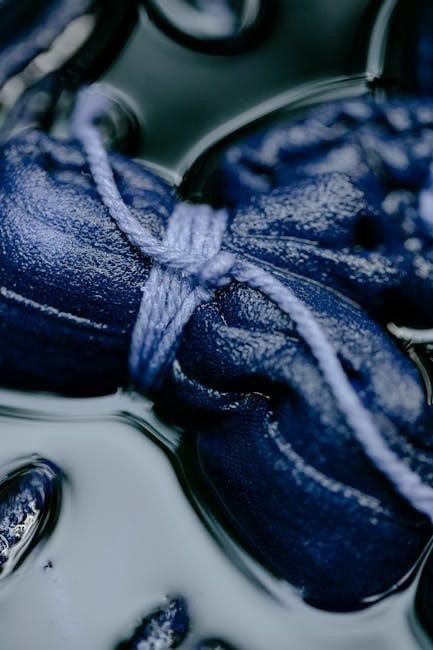
Common Mistakes to Avoid
Common mistakes include using hot water too early‚ not rinsing thoroughly‚ and washing tie-dye with other clothes‚ which can cause color bleeding and fading.
8.1 Using Hot Water Too Early
Using hot water immediately after dyeing can cause colors to fade rapidly. Hot water opens fabric fibers‚ leading dye to rinse out unevenly. This results in muted tones and inconsistent patterns. It’s crucial to rinse with cold water first to stop the dye reaction and then gradually introduce warmer temperatures for washing. Always check the dye kit instructions for optimal temperature settings to maintain vibrant colors and prevent premature fading.
8.2 Not Rinsing Thoroughly Before Washing
Not rinsing tie-dye items thoroughly before washing can lead to excess dye residue‚ causing color bleeding and unevenness. Always rinse under cold water until the runoff is nearly clear to prevent this issue. Proper rinsing stops the dye reaction and removes loose pigment‚ ensuring vibrant colors stay intact. Skipping this step risks faded or discolored patterns‚ especially when washing with other clothes. Thorough rinsing is a critical step for maintaining the integrity and appearance of tie-dye designs.
8.3 Washing Tie-Dye with Other Clothes
Washing tie-dye items with other clothes can cause dye transfer‚ ruining other garments. Even after rinsing‚ residual dye may bleed‚ especially in hot water. To protect both the tie-dye and other clothes‚ it’s best to wash them separately‚ especially in the initial washes. Using a dye-safe detergent and cold water helps minimize color bleeding. Always check the care label and follow specific instructions to ensure colors remain vibrant and avoid accidental staining of other fabrics.
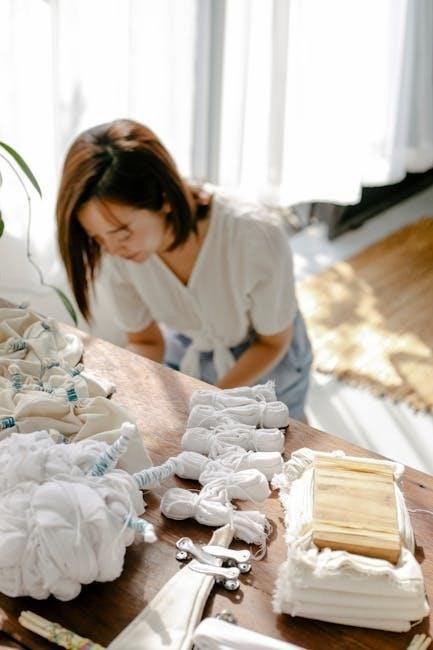
Troubleshooting Fading or Uneven Colors
Fading or uneven colors can occur due to improper washing or dyeing techniques. Re-dyeing or using vinegar soaks may help restore vibrancy and fix uneven patterns effectively.
9.1 Why Colors Fade
Colors fade due to improper washing techniques‚ such as using hot water too early or not rinsing thoroughly. Over-washing and exposure to harsh detergents can also cause fading. Additionally‚ if the dye isn’t properly fixed during the initial process‚ it may bleed or lose vibrancy over time. Ensuring the dye sets correctly and following care instructions can help prevent fading and maintain the tie-dye design’s integrity.
9.2 Re-Dyeing or Touching Up
Re-dyeing or touching up can restore faded tie-dye colors. Start by washing the fabric to remove dirt and excess dye residue. Use a dye-safe detergent and cold water to prepare the fabric. Apply new dye to faded areas‚ following the manufacturer’s instructions. For best results‚ soak the item in a vinegar solution before re-dyeing to help set the colors. After re-dyeing‚ rinse thoroughly and wash separately to prevent color bleeding. This method revives vibrant patterns and extends the life of your tie-dye design.
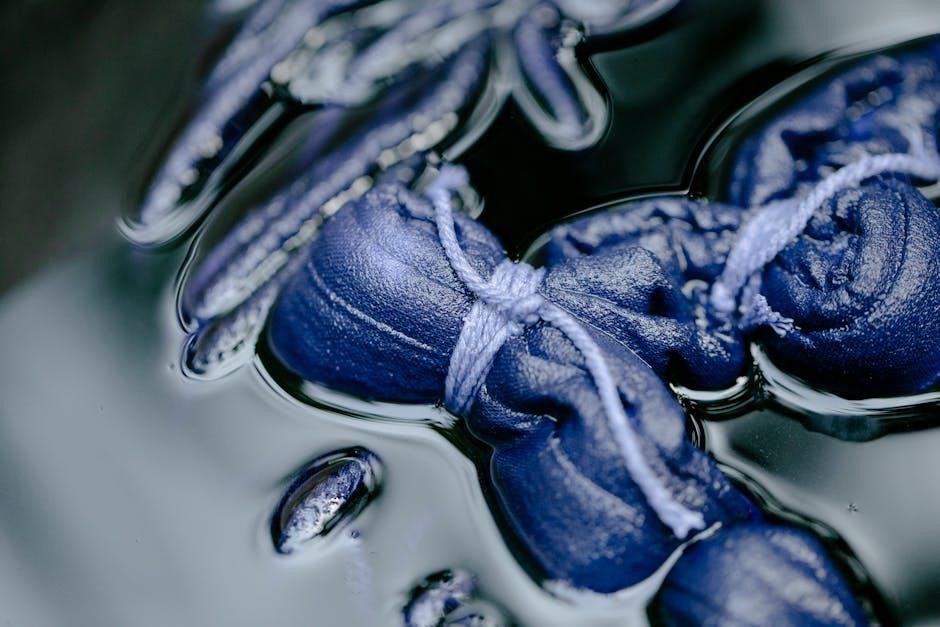
Special Techniques for Tie-Dye Washing
Special techniques like hand washing and using fixatives enhance color retention. These methods ensure vibrant‚ long-lasting results while preserving intricate tie-dye patterns and designs effectively.
10.1 Hand Washing for Delicate Items
Hand washing is ideal for delicate tie-dye fabrics like silk or rayon. Use cold water and a mild detergent to gently agitate the fabric‚ avoiding harsh scrubbing. Soak for 10-15 minutes to remove excess dye without damaging fibers. Rinse thoroughly until water runs clear‚ then gently squeeze out moisture without wringing. This method preserves colors and maintains fabric integrity‚ ensuring delicate items remain vibrant and intact after washing.
10.2 Using Synthrapol for Dye Fixation
Synthrapol is a specialized detergent designed to fix dyes and prevent color bleeding. After dyeing‚ wash the fabric in hot water using Synthrapol to remove excess dye and lock in colors. This step ensures vibrant hues and prevents fading. It’s especially effective for dark or heavily dyed items. Follow the instructions on the product label for the correct dosage. Regular use of Synthrapol helps maintain the integrity of the tie-dye design and keeps the fabric colorfast over time‚ making it a crucial tool for professional results.
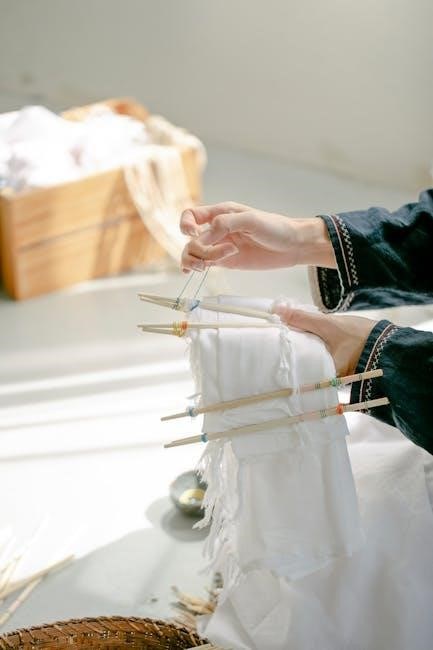
Environmental Considerations
Use eco-friendly dyes and proper disposal methods to minimize environmental impact. Opt for natural fixatives like vinegar to reduce chemical runoff and protect water systems.
11.1 Eco-Friendly Dyeing and Washing Practices
Eco-friendly dyeing involves using natural or low-toxic dyes. Proper disposal of dye waste is crucial to prevent water contamination. Washing tie-dye items separately initially reduces excess dye runoff. Using cold water and eco-conscious detergents minimizes environmental impact. Air drying instead of machine drying saves energy and preserves colors better. For fixation‚ vinegar is a sustainable alternative to chemicals. These practices help maintain vibrant colors while protecting the environment and promoting sustainable fashion.
11.2 Disposal of Dye Waste
Proper disposal of dye waste is crucial to prevent environmental harm. Allow dye mixture to settle‚ then dispose of it in a sealed container. Never pour dye waste down drains or waterways. Check local regulations for hazardous waste disposal guidelines. Always clean tools and surfaces thoroughly to avoid contamination. Eco-friendly practices ensure sustainability and protect ecosystems from chemical runoff. Proper disposal helps maintain a greener and safer environment for everyone.
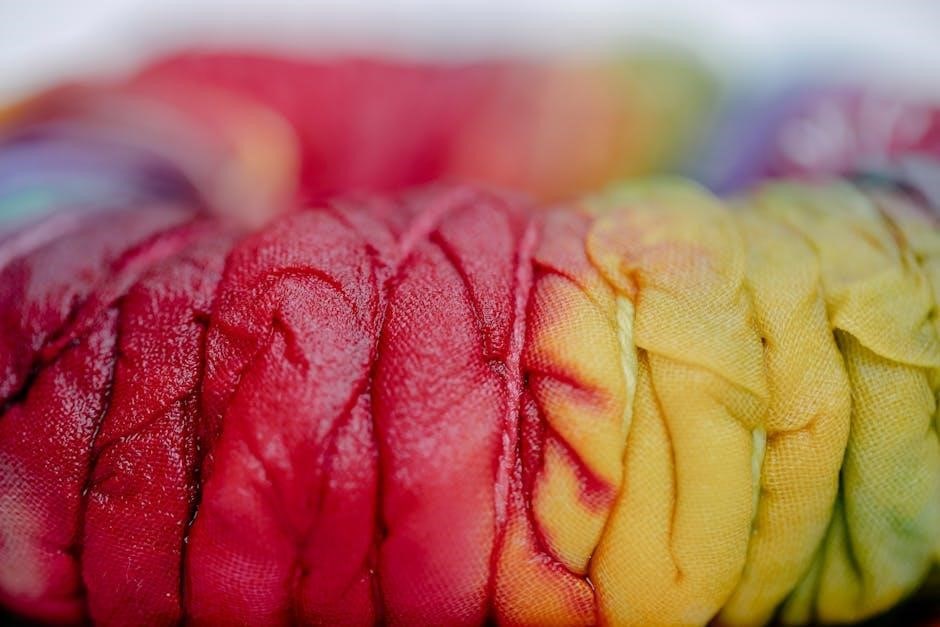
Alternative Methods for Setting Dye
Use vinegar soak or salt water to fix colors. These methods enhance dye retention and prevent fading‚ ensuring vibrant results without harsh chemicals.
12.1 Using Vinegar for Color Fixation
Vinegar is a natural fixative for tie-dye colors. After rinsing excess dye‚ soak the fabric in a solution of equal parts white vinegar and cold water for 30 minutes. This step helps lock the colors‚ preventing them from fading during subsequent washes. The acidity in vinegar balances the dye molecules‚ ensuring vibrant and long-lasting results. This method is eco-friendly and gentle on fabrics‚ making it ideal for preserving intricate tie-dye patterns without damaging the material.
12.2 Soaking in Salt Water
Soaking tie-dye fabrics in salt water helps fix colors and prevent fading. Dissolve 1 cup of salt in a gallon of cold water and soak the fabric for 30 minutes to an hour. This method is particularly effective for cotton and linen‚ as it enhances color retention and reduces bleeding. Salt water acts as a natural dye fixative‚ ensuring vibrant hues remain intact. It’s a simple‚ eco-friendly technique that complements other fixation methods‚ like vinegar‚ to maintain the integrity of your tie-dye design.
Proper tie-dye washing preserves vibrant colors and prevents fading. Following best practices ensures long-lasting results‚ while creative experimentation keeps your designs fresh and unique over time.
13.1 Summary of Best Practices
Effective tie-dye washing involves rinsing under cold water‚ using dye-safe detergents‚ and washing items separately. Air drying or low-heat machine drying preserves colors. Regular care includes cold water washing and color-protecting detergents. Special fabrics like silk require gentle handling. Avoiding hot water too early and thorough rinsing are crucial. These practices ensure vibrant‚ long-lasting results while maintaining fabric integrity and preventing color bleeding or fading over time.
13.2 Encouragement to Experiment Safely
Don’t hesitate to explore creative tie-dye techniques while adhering to safety guidelines. Start with small projects to test methods and materials. Experiment with different dyes and folding styles to achieve unique patterns. Always wear protective gloves and work in a well-ventilated area. Remember‚ practice makes perfect—each attempt refines your skills. Embrace mistakes as learning opportunities to enhance your tie-dye craft and create personalized‚ one-of-a-kind designs with confidence and flair.

o positive blood type diet pdf
You May Also Like

birds of colorado field guide
July 21, 2025
carnivore diet food list pdf
June 11, 2025
